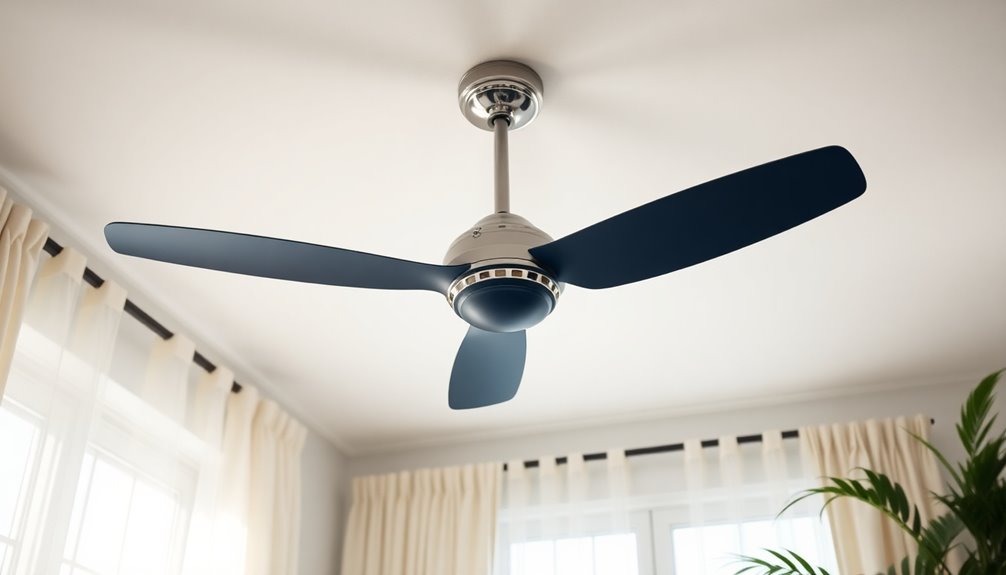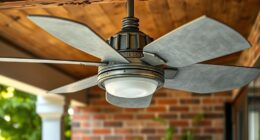Yes, you can definitely paint a ceiling fan to give it a fresh look and match your decor. It's a cost-effective way to revitalize an outdated fixture. Start by gathering quality spray paint and preparing the surfaces by cleaning and sanding them. Make sure to turn off the power and wear protective gear while working. Apply a thin coat of primer first, then use your chosen paint color. After allowing everything to dry, reassemble the fan. This simple DIY project can transform your fan into a unique piece of art. There's more to explore about techniques and tips!
Key Takeaways
- Yes, you can paint a ceiling fan to revitalize its appearance and match your room decor.
- Use quality spray paint with primer for a durable finish on fan surfaces.
- Proper preparation, including cleaning and sanding, ensures better paint adhesion.
- Always turn off power and use safety gear to protect yourself during the process.
- Allow all painted components to dry for at least 24 hours before reassembly.
Benefits of Painting a Ceiling Fan

Painting a ceiling fan can breathe new life into your living space. It's a cost-effective way to transform outdated fixtures into stylish focal points without the expense of replacement. By choosing to paint the fan, you're not just revitalizing an old piece but also customizing it to match your existing decor.
Whether your furniture is modern or traditional, you can select colors that complement your style, including shades that blend seamlessly with white ceiling fans.
Applying a new coat of paint doesn't just enhance aesthetics; it allows you to express your personal style. You can turn a mundane ceiling fan into a unique art piece that stands out or blends perfectly with your ceiling color. This approach creates a cohesive look, making your room feel more modern and inviting.
Moreover, the process is simple and requires minimal investment and effort. By updating the fan's appearance, you can greatly improve the visual appeal of the room without the hassle of a complete remodel.
Required Materials for the Project

Before you start painting your ceiling fan, gather essential supplies like quality spray paint with primer and fine-grit sandpaper for prepping the surface.
You'll also need cleaning materials, such as a damp cloth or all-purpose cleaner, to guarantee the paint adheres properly.
Don't forget to grab protective gear and a drop cloth to keep your workspace clean and safe.
Essential Painting Supplies
To tackle the project of painting your ceiling fan, you'll need a few essential supplies to guarantee a smooth and successful process. First and foremost, choose a high-quality Enamel Spray Paint, like Rust-Oleum Satin Enamel, which provides a durable and attractive finish. If you want extra coverage, consider using a primer before applying the paint.
You'll also need 120 grit sandpaper to prepare the surfaces by smoothing out any rough spots and removing old paint or debris. Cleaning supplies are crucial too; grab some mild soap, water, baby wipes, and gloves to make certain all fan parts are free from dust and grime before you paint the ceiling fan.
Don't forget about protecting your workspace—drop cloths or newspapers will help catch any overspray.
Finally, having a circuit tester on hand is a smart move to confirm that the power is off before you start your project. With these essential supplies gathered, you're all set to give your ceiling fan a fresh new look!
Surface Preparation Tools
When preparing to paint your ceiling fan, having the right surface preparation tools is fundamental for achieving a professional finish. Start with 120 grit sandpaper to lightly sand the wooden blades. This process helps guarantee proper paint adhesion, making your paint job last longer.
Next, grab a damp cloth or an all-purpose cleaner to remove dust and debris from all fan components. A clean surface is essential for a smooth application.
Don't forget to wear disposable gloves to protect your hands from both paint and cleaner during this preparation stage.
You'll also need a screwdriver to disassemble the fan. This step allows you easier access to the blades and other parts that require painting, assuring you don't miss any spots.
Finally, masking tape and paper are critical for covering areas that shouldn't be painted. Properly applying masking tape will prevent overspray and help you achieve clean lines, giving your ceiling fan a polished look.
With these surface preparation tools in hand, you're ready to transform your ceiling fan into a stunning feature of your room!
Preparation Steps Before Painting

Before you start painting, make sure to turn off the power at the circuit breaker to keep yourself safe.
Next, consider choosing paint colors that will complement the existing hardware in your room for a polished look.
With these steps in mind, you'll be ready to transform your ceiling fan.
Choose Complementary Colors
Choosing complementary colors for your ceiling fan can really tie the room together. Start by considering shades that match your existing hardware, like hinges and knobs, to create a cohesive look. Aim for blade colors that harmonize with nearby furniture and cabinetry, ensuring a unified design aesthetic throughout the space.
Neutral colors, such as whites, grays, and beiges, are excellent choices. They blend seamlessly with various decor styles and allow for easy updates in the future. Before you settle on a color, gather paint swatches or samples. This step helps you visualize how the chosen colors will interact with the room's lighting and other elements.
Think about the overall theme of your room. If you're aiming for a vibrant, playful space, opt for bold hues that pop. Conversely, if you want a calming environment, softer tones may be more appropriate.
Turn Off Power
It's vital to always turn off the power at the circuit breaker before you start painting your ceiling fan. This important step guarantees your safety and prevents any accidental electrical hazards while you work.
Once you've located the circuit breaker, flip the switch that controls your ceiling fan.
To verify you're in the clear, use a circuit tester to confirm that the power is off. Here are some important steps to follow:
- Check the circuit tester: Test it on a live receptacle first to verify it's working correctly.
- Confirm disconnection: Make sure the ceiling fan is completely disconnected from the power source.
- Avoid accidents: If you need to remove the fan, consider asking a friend for help, especially if you're working at heights.
- Stay alert: Keep the area clear of distractions while you work to maintain focus.
Taking these precautions will help you paint your ceiling fan safely and effectively.
Steps to Paint the Ceiling Fan

To begin painting your ceiling fan, start by sanding the blades to remove any old paint and debris. This step helps improve paint adhesion, guaranteeing a smoother finish.
Once you've sanded the fan blades, clean all parts thoroughly with soap and water. This will help confirm that surfaces are free of dust and grime before applying paint.
Next, apply a thin, even coat of primer to the blades and body of the fan. Allow the primer to dry completely before moving on to the color coats.
Use quality spray paint for the best results, maintaining a distance of 6-8 inches while spraying. This distance helps achieve an even application without drips, which is vital for a professional-looking finish.
After applying the color coats, be sure to allow all components to dry for at least 24 hours. This waiting period is significant, as it guarantees the paint cures properly.
Finalizing the Project

Once the paint has dried completely, you can begin reassembling your ceiling fan. Carefully follow the original configuration to guarantee proper functionality. Start by securely reconnecting the wiring: match black wires to black and white wires to white.
Don't forget to attach the grounding wires to the metal junction box for safety.
Before you finish, consider adding a personal touch with stencils. Applying unique designs on the fan blades can make your ceiling fan stand out even more.
Here's a quick checklist for the final assembly:
- Confirm all painted components are dry.
- Double-check wiring connections for accuracy.
- Restore power at the circuit breaker.
- Test the fan to verify it operates correctly.
Once everything's in place, turn on your ceiling fan and admire your handiwork! This paint makeover not only enhances its appearance but also breathes new life into your space.
Finally, make it a habit to regularly check and clean the fan to maintain its look and promote longevity. Enjoy your beautifully painted ceiling fan, and revel in the satisfaction of a job well done!
Safety Precautions to Follow

Safety should always be your top priority when painting a ceiling fan. Before you start, make sure to turn off power at the circuit breaker. This step is essential to prevent any electrical hazards.
Use a high-voltage neon tester to verify that the power is truly off before touching any wires or fan components.
When it comes to disassembling the fan, it's wise to enlist an assistant. This not only helps you safely remove the fan from the ceiling but also reduces the risk of dropping or damaging it.
As you prepare to paint, remember to wear gloves and a mask. These safety precautions will protect your skin and lungs from paint fumes and particles that can be harmful.
Additionally, confirm your workspace is well-ventilated to minimize exposure to any harmful chemicals in the paint and primer.
Community Feedback and Inspiration

After taking the necessary safety precautions, you might find yourself excited to explore the community's feedback and inspiration surrounding ceiling fan painting.
Many DIY enthusiasts have discovered that painting a ceiling fan is an effective and cost-efficient way to refresh dated ceilings and enhance your room's overall aesthetic.
Community discussions reveal countless tips and experiences that can guide you through your project. Here are some highlights from fellow DIYers:
- Transformative Success: Users often share before-and-after photos that demonstrate the dramatic impact a simple paint job can have.
- Creative Techniques: Many participants showcase unique painting methods that blend ceiling fans seamlessly with their room decor.
- Common Challenges: DIYers discuss the obstacles they faced, offering solutions that can help you avoid similar pitfalls.
- Global Inspiration: Positive feedback from users, including those in Australia, emphasizes the satisfaction of a successful makeover.
Engaging in these community discussions not only provides valuable insights but also fosters a sense of camaraderie among DIY fans.
Future Project Considerations

When planning future DIY projects, it's essential to assess the quality and brand of your ceiling fan, as models like Casablanca are renowned for their durability and performance. Energy-efficient technology can also be a consideration when choosing the right fan, as it may contribute to lower energy bills. Additionally, many ceiling fans on the market today feature reversible motors, allowing for versatile airflow throughout the year.
If you're thinking about painting your ceiling fan, make certain it's a sturdy model that can withstand the transformation. Incorporating natural materials into your home decor can further enhance the overall aesthetic and complement your painted fan. It's also important to consider how diversified investments in your home can lead to greater long-term value.
Additionally, reflect on how this project fits into your broader home aesthetic. You might want to paint a ceiling fan in conjunction with other fixtures, like kitchen cabinets, to create a cohesive look. This approach not only enhances your space but also allows you to experiment with color and design.
Don't forget to take into account the rotation direction of the fan blades. Adjusting this can notably improve cooling efficiency in the room, making your painted fan not just a visual upgrade but a functional one, too.
Stay informed about new trends and techniques in home improvement to inspire your future projects. Engaging with the DIY community can provide valuable insights and tips for painting techniques, making sure you're well-prepared for your ceiling fan makeover and any upcoming renovations. Additionally, consider setting specific savings goals to budget for your project, ensuring you have the funds necessary for any materials or tools needed.
Engaging With DIY Enthusiasts

Connecting with DIY enthusiasts can greatly enhance your painting project, as their shared experiences and tips provide invaluable insights.
By engaging with this vibrant community, you'll discover new techniques and product recommendations that can elevate your ceiling fan transformations.
Plus, sharing your journey can inspire others to tackle similar projects, leading to collective project successes.
To get started, consider these strategies:
- Join social media platforms like Instagram and Pinterest to showcase your fan transformations.
- Participate in discussions within DIY groups to exchange ideas and solutions.
- Use specific hashtags to increase visibility and connect with fellow DIY enthusiasts.
- Celebrate your project successes and encourage others to share theirs.
Frequently Asked Questions
What Paint to Use on a Ceiling Fan?
When choosing paint for a ceiling fan, opt for semi-gloss primer and paint for wood blades to guarantee durability and a nice sheen.
For metal blade brackets, use gloss spray paint, while the fan's metal body benefits from gloss brush-on paint.
Consider quality options like Rustoleum Ultra Cover in Gloss White or Glidden Complete Paint + Primer.
Always apply light coats for better adhesion and sand surfaces beforehand for a smoother finish.
Is It Safe to Paint a Ceiling Fan?
Did you know that nearly 70% of homeowners choose to update their ceiling fans for a fresh look?
It's safe to paint a ceiling fan if you take the right precautions. Start by turning off the power and using a circuit tester to confirm it's off.
Disassemble the fan carefully and use non-toxic spray paint. Work in a ventilated area, and don't forget to let it dry completely before reassembling and powering it back on.
How Do I Change the Color of My Ceiling Fan?
To change the color of your ceiling fan, start by safely disassembling it and turning off the power at the circuit breaker.
Clean all parts thoroughly and let them dry.
Lightly sand the blades for better paint adhesion, then wipe off any dust.
Use quality spray paint, applying several light coats and letting each dry in between.
Once everything's painted and dried, reassemble the fan and restore power to enjoy your refreshed look.
How to Paint a Ceiling Fan Without Removing It?
To paint your ceiling fan without removing it, start by turning off the power at the circuit breaker.
Use masking tape and paper to cover areas you want to protect from overspray. Lightly sand the blades for better paint adhesion and clean them thoroughly.
Then, apply several light coats of spray paint, maintaining a distance of 8 to 12 inches. Allow adequate drying time between coats, and be sure to ventilate the area well.
Conclusion
In the end, painting your ceiling fan can breathe new life into your space and showcase your creativity. Remember, "a little paint goes a long way," so don't hesitate to transform that old fan into a stylish centerpiece. By following the steps and safety precautions, you'll not only achieve a fresh look but also gain confidence in your DIY skills. So grab those brushes and get started—your ceiling fan is waiting for its makeover!









